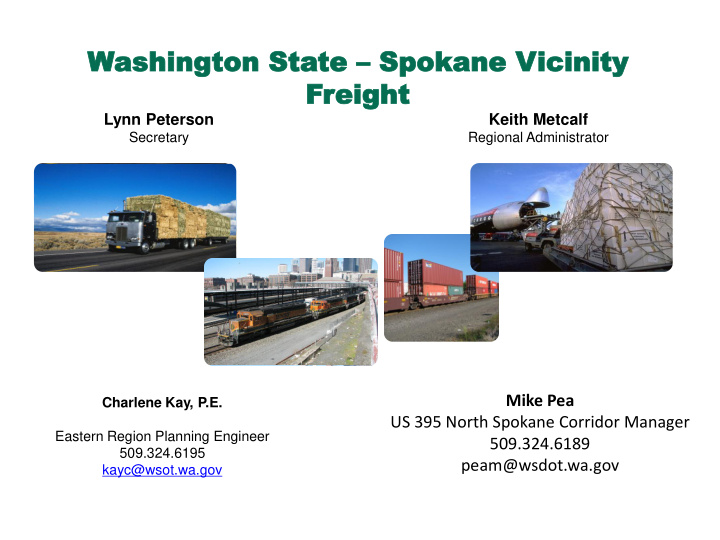



Washing ashington Sta ton State te – Spok Spokane V ane Vicinity icinity Freight eight Lynn Peterson Keith Metcalf Secretary Regional Administrator Mike Pea Charlene Kay, P.E. US 395 North Spokane Corridor Manager Eastern Region Planning Engineer 509.324.6189 509.324.6195 peam@wsdot.wa.gov kayc@wsot.wa.gov
Freight Matters Washington’s freight system is important to the economy of our state and country in many ways. • It underpins our national and state economies, supports national defense, directly sustains hundreds of thousands of jobs, and delivers the necessities of life to residents on a daily basis. Goods are shipped into, out of, and around Washington through our system of roads, railroads, marine and air ports, waterways, and other intermodal facilities. WHY does freight MATTER to Washington? • Maintains the urban goods movement system, supporting jobs, the economy, and clean air for all; and provides goods delivery to residents and businesses. • Keeps Washington competitive as a Global Gateway for the State, nation and world. • Supports rural economies’ farm -to-market, manufacturing, and resource industry sectors.
2014 2014 Wash ashington ington Sta State te Freight eight Mobility Mobility Plan Plan Lynn Peterson Cam Gilmour Secretary Deputy Secretary Barbara Ivanov Director, Freight Systems Division ivanovb@wsdot.wa.gov The full Washington State Freight Mobility Plan may be found at: http://www.wsdot.wa.gov/Freight/freightmobilityplan
What are the Key Deliverables in the State Freight Plan? The Washington State Freight Plan has: 1. Identified the Washington State Freight Truck, Rail and Waterway Economic Corridors, including first and last mile connector routes based on freight-intensive land use. 2. Set measurable freight performance goals for the State Truck and Waterway Freight Economic Corridors. 3. Systematically analyzed current performance gaps and needs on highways in State Truck Freight Economic Corridors. 4. Developed a new process to include Tribal, Metropolitan Planning Organization (MPO), Regional Transportation Planning Organization (RTPO), port and state freight strategies to improve performance on the Washington State Economic Freight Corridors in the Plan. 4
Truck Freight Performance Measures CONFORMS TO NATIONAL FREIGHT GOALS Informed by research, data, analysis, and stakeholder input, this Plan will improve Washington’s ability to achieve national freight goals: • Improve the contribution of the freight transportation system to economic efficiency, productivity, and competitiveness • Reduce congestion on the freight transportation system • Improve the safety, security, and resilience of the freight transportation system • Improve the state of good repair of the freight transportation system • Use advanced technology, performance management, innovation, competition, and accountability in operating and maintaining the freight transportation system • Reduce adverse environmental and community impacts of the freight transportation system The Washington State Department of Transportation (WSDOT) will use these six measures to track the performance of the Truck Freight Economic Corridors. Reducing: Improving: 1. Truck travel time 4. Economic output 2. Direct truck operating costs 5. Network resiliency 3. Truck engine emissions 6. Reliability 5
We Have a Strong Freight System in Washington 78,105 Jobs $6.4 billion RDP 105,098 Jobs $6.3 billion RDP 179,463 Jobs $10.8 billion RDP 892,721 Jobs $91.9 billion RDP 45,893 Jobs $2.5 billion RDP 56,716 Jobs $3.2 billion RDP 106,841 Jobs $7.7 billion RDP Freight Dependent Industries support 1.46 million jobs and $128.8 billion in regional domestic product statewide. 6
Washington State Truck Freight Economic Corridors 7
Wheat Supply Chain: Example Freight Mobility Improvements West Vancouver Freight Access New freight rail entrance to the Port of Vancouver from the mainline and internal rail track storage to accommodate unit trains. PCC Freight Rail Preservation Multiple preservation and rehabilitation projects. Ice Harbor Lock & Dam Lock and dam maintenance project. Wheat is a $1.14 billion industry in Washington State 8
Aerospace Supply Chain: Example Freight Mobility Improvements I-5 Tacoma to Everett mobility improvements Multiple improvements to I-5. Phase I -Re-designation of SR 529 & Improvements Access improvements from Port of Everett to I-5 and intersection improvements to better accommodate over- dimensional freight traffic. I-90 Snoqualmie Pass--widen to Easton Widening and interchange improvements. Aerospace products and part are a $52.2 billion industry in Washington State 9
US 395 NORTH SPOKANE CORRIDOR The EIS states that the purpose for this project is: “ to improve the efficiency of the people- and freight-carrying capacity on and between city streets, county roads, and major north side transportation routes, particularly US 2 and US 395 .” The following were documented as the needs for the project: • Rapid growth in the northern suburban and eastern valley suburban areas • Economic development dependent upon transportation facilities • Anticipated degradation of existing arterials • Lacking connections to public transportation, and between rail and truck • Need to reduce the number of vehicles using the existing arterial system east of Division Street and north of I-90
2011- 2012
2010- 2011
Recommend
More recommend